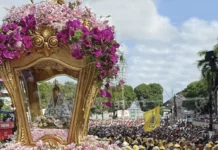Carmelites of Vietnam celebrate return to monastery
On the Solemnity of St. Joseph, the Archbishop of Hue, Vietnam, presided over a Thanksgiving Eucharist to commemorate the 25th anniversary of the return of the Discalced Carmelite Nuns to their monastery, confiscated by the communist regime in 1975. Fifty priests and three hundred lay people attended the celebration.
In his homily, Archbishop Joseph Nguyen Chi Linh emphasised how much support was found in the Holy Patriarch by the nuns, who had to endure great physical, moral and psychological sufferings during those difficult times.
Later during the same Mass, the celebrant, who is also president of the Catholic Bishops’ Conference of Vietnam, blessed a newly built belfry, a two-metre-high image of the Spouse of Mary and a number of wooden crosses.
The monastery currently holds fifty-five nuns and nine novices, who dedicate their lives to prayer and sacrifice for the benefit of priests, the needy and the Catholic Church in Vietnam.
On the same day, Cardinal Pierre Nguyen Van Nhon, Archbishop emeritus of Hanoi, presided at a Mass concelebrated by two other Bishops to commemorate the 160th anniversary of the Carmelites’ arrival in the country. In 1860, four nuns landed in Saigon to found the first monastery, led by Mother Philomena of the Immaculate Conception, a Frenchwoman from Lisieux. Today the Order has ten convents in Vietnam, which house a total of almost 300 cloistered nuns.
Virgin of the Forsaken passes through the streets of Valencia
Since it was not possible this year to make the traditional flower offering to the Virgin of the Forsaken, due to the COVID-19 pandemic, the Archbishop of Valencia, Spain, Cardinal Antonio Cañizares Llovera, decided to reverse the roles, taking the statue of the Mother of God as a pilgrim among the faithful.
Accordingly, between March 15 and 17, the statue, affectionately called La Geperudeta by the Valencians, was carried through the city streets in a vehicle, especially passing close to hospitals, allowing her devotees to greet Her and pray from a distance.
During the entire trip, the hymn to the Patroness and other religious songs resounded in the streets via loudspeakers. The route was not announced in advance, which resulted in surprise and excitement for those who met with the statue. They expressed their joy with cheers and applause for the Blessed Virgin.
Church in Brazil’s Rio Grande do Norte becomes minor basilica

On March 25, the Brazilian state of Rio Grande do Norte obtained its first basilica. It is the Mother Church of Our Lady of Guidance, elevated to the category of minor basilica by a decree issued by the Congregation for Divine Worship and the Discipline of the Sacraments. The document was read at the end of the altar dedication ceremony, by Diocesan Bishop Antônio Carlos Cruz Santos, MSC.
According to the words of Fr. Fabiano Maurício Dantas, rector of the new basilica, the title was granted due the architecture of the church and its historical importance.
The Parish of Our Lady of Guidance, erected in 1835 in the city of Acari, is one of the oldest in the state. Its mother church, inaugurated in 1867, became a reference point of Marian piety for the faithful of neighbouring municipalities. In fact, this invocation of the Blessed Virgin was the first to be venerated in the Seridó, the region of Rio Grande do Norte where Acari is located. The beginning of the devotion dates back to the year 1738, when the construction of a chapel dedicated to Her marked the foundation of the village that in the following decades would give rise to the city.
Priest and faithful are murdered in Nigeria
On March 30, Tuesday of Holy Week, Fr. Ferdinand Fanen Ngugban and six parishioners were killed in a terrorist attack on St. Paul Parish in the community of Aye-Twar, Nigeria.
Fr. Ferdinand had just finished celebrating the Eucharist and was preparing to attend the Chrism Mass in St. Gerard Majella Cathedral when, hearing noises outside the church, he went outside to discover the cause. There he was ambushed by armed men who shot him before he could take any steps to protect himself. His body was found later with a bullet wound in the back of the head, together with six other victims. The band of criminals also robbed the community and set fire to several houses.
The attack came just days after another priest, Fr. Harrison Egwuenu, was released from a week-long kidnapping. In the face of growing religious persecution in the country, Archbishop Ignatius Ayau Kaigama of Abuja stressed the “urgent need for the Nigerian government to address the situation by training security agents to act more effectively.”
New international pilgrimage site in Asia

The Vatican has proclaimed the South Korean Shrine of Haemi, scene of the martyrdom of thousands of Catholics, as a place of international pilgrimage, according to an announcement made by Bishop Lazarus You Heung-sik of Daejeon on March 1. It is the second site in South Korea and the third in Asia to receive this recognition.
Located 180 kilometres from Seoul, the Haemi Shrine bears witness to the faith of approximately 2,000 Catholics who, between 1866 and 1882, were imprisoned, tortured and buried alive during the persecution carried out by the kings of the Joseon Dynasty. Most of these martyrs remain anonymous, for only 132 of their names have been officially registered.
Churches Desecrated during Feminist Demonstrations
T
he demonstrations held on International Women’s Day, March 8, became the occasion for desecrations and acts of vandalism against churches in several Latin American cities.
In Bogota, a group of women attacked San Francisco Church, one of the most popular in Colombia. They attempted to set fire to the church’s main door and spray-painted the exterior walls. The prompt intervention of authorities prevented more extensive damages from occurring. One of the rioters threw a cross into the fire, bearing a message offensive to the Catholic Faith.
There were also attacks on the Cathedral of Ibagué in Colombia, prompting the parish priest, Fr. Felix García Angarita, to express his perplexity: “They are sullying the image of women, which is one of tenderness, openness, fraternity, and kindness, not vandalism.”
On the same day, in Argentina, police forces were called upon to defend the Cathedral of Salta against another attack carried out by a group of women, who hurled stones, canes and lit torches at it, while chanting blasphemous slogans. A pilgrim image of the Lord of the Miracle was damaged during this episode.
In Mexico there were similar demonstrations. Participants in the feminist march held in the city of Oaxaca entered the Church of Sts. Cosmas and Damian violently, painted graffiti on walls, windows and furniture and damaged the statue of St. Jude Thaddeus. Other buildings were also damaged by the same group.











